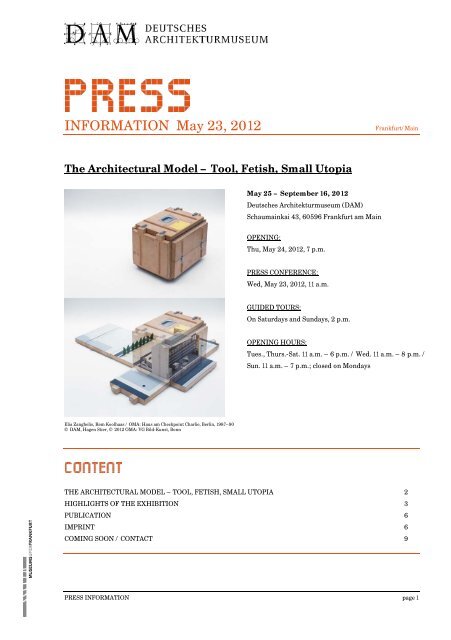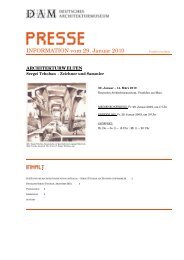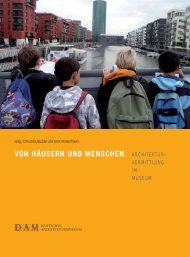PDF file - Deutsches Architektur Museum
PDF file - Deutsches Architektur Museum
PDF file - Deutsches Architektur Museum
Create successful ePaper yourself
Turn your PDF publications into a flip-book with our unique Google optimized e-Paper software.
INFORMATION May 23, 2012 Frankfurt/Main<br />
The Architectural Model – Tool, Fetish, Small Utopia<br />
Elia Zanghelis, Rem Koolhaas / OMA: Haus am Checkpoint Charlie, Berlin, 1987–90<br />
© DAM, Hagen Stier, © 2012 OMA: VG Bild-Kunst, Bonn<br />
May 25 – September 16, 2012<br />
<strong>Deutsches</strong> <strong>Architektur</strong>museum (DAM)<br />
Schaumainkai 43, 60596 Frankfurt am Main<br />
OPENING:<br />
Thu, May 24, 2012, 7 p.m.<br />
PRESS CONFERENCE:<br />
Wed, May 23, 2012, 11 a.m.<br />
GUIDED TOURS:<br />
On Saturdays and Sundays, 2 p.m.<br />
OPENING HOURS:<br />
Tues., Thurs.-Sat. 11 a.m. – 6 p.m. / Wed. 11 a.m. – 8 p.m. /<br />
Sun. 11 a.m. – 7 p.m.; closed on Mondays<br />
THE ARCHITECTURAL MODEL – TOOL, FETISH, SMALL UTOPIA 2<br />
HIGHLIGHTS OF THE EXHIBITION 3<br />
PUBLICATION 6<br />
IMPRINT 6<br />
COMING SOON / CONTACT 9<br />
PRESS INFORMATION page 1
The Architectural Model – Tool, Fetish, Small Utopia Frankfurt / Main, 23/05/2012<br />
THE ARCHITECTURAL MODEL – TOOL, FETISH, SMALL UTOPIA<br />
Extending over all the levels of the <strong>Museum</strong> the exhibition demonstrates how architects have worked with<br />
architectural models since about 1920, and highlights the latest developments. Following intensive<br />
research work enabled by the Kulturfonds Frankfurt RheinMain architectural models will be placed in a<br />
new light, namely within the context of how architects employ them - as tools, fetishes or to try out<br />
utopias.<br />
THE ARCHITECTURAL MODEL<br />
Architectural models, and not as is generally the case the buildings, which were planned with the help of<br />
the model, are the focal point of this exhibition. There have been architectural models for many centuries,<br />
but since the early 20th century they have been produced in greater numbers and for more diverse<br />
purposes than ever before. There are several reasons for this: The most important is the discovery of<br />
photography and the development of printing techniques for photo reproduction. If an effective photo of a<br />
model can be made, in other words it serves as a “photo model”, the effort of making the model is doubly<br />
worthwhile: Books, magazines, and even films can draw attention to the photo far more easily than to<br />
the real model. For this reason lots of models in the exhibition are contrasted with photos depicting the<br />
model as the architect wished to see it published.<br />
TOOL<br />
There are models without which a planned architectural project would never have been realized. Without<br />
Frei Otto’s soap film, structural engineering and surveying models, many of his projects would not have<br />
been feasible. A model can also be a seductive tool the architect uses to win over the client or the public. A<br />
model is more graphic than plans. However, models can lie as well. Moreover, most architectural models<br />
are more reduced, more abstract than the “doubtful cases” in the showcase on the left. Architectural<br />
models are frequently promises, leave later design and construction-related developments open, and not<br />
perfectionist miniatures.<br />
FETISH<br />
Many models display more than a miniaturized copy. They are made of precious, sometimes remarkable<br />
materials, show an ideal state of affairs, and not reality. They are a fetish and “substitute activity”: Many<br />
models are more convincing than the project that was actually realized.<br />
SMALL UTOPIA<br />
In the 1960s in particular utopias architecture could not be big enough. Giant urban utopias were to be<br />
the architectural companions of social utopias. Models often portrayed these visionary designs.<br />
PRESSEINFORMATION Seite 2
The Architectural Model – Tool, Fetish, Small Utopia Frankfurt / Main, 23/05/2012<br />
HIGHLIGHTS OF THE EXHIBITION<br />
102 models from the DAM<br />
Some 300 exhibits will feature in the show and one third of them stems from the DAM collection. Based<br />
on acquisitions made by the founding director Heinrich Klotz (between 1979 and 1989) the DAM today<br />
boasts one of the world’s largest, most renowned collections of architectural models. At the last count the<br />
DAM has in its possession 1,240 models by 419 architects from 25 countries. Highlights being displayed<br />
in the exhibition for the first time in years include the suspension models by Frei Otto but also two<br />
enormous models each measuring twelve square meters by Rem Koolhaas representing urban<br />
development plannings in Paris La Villette (1983) and Melun-Sénart (1987) respectively.<br />
200 loans<br />
Two thirds of the exhibits are loans, for example from the <strong>Museum</strong> of Modern Art, New York, the FRAC<br />
Centre Orléans, <strong>Deutsches</strong> <strong>Museum</strong> Munich and several Berlin architectural collections. Many architects<br />
are also lending the <strong>Museum</strong> models: for example, some 50 working models of the Prada Store in Tokyo<br />
from Herzog & de Meuron (Basel) will be displayed. Styrodur models by Axel Schultes and Charlotte<br />
Frank from Berlin will be shown in magical looking dark, back-lit cabinets.<br />
Some of the items on loan, including three models from the MoMA in New York, are truly extraordinary:<br />
the oldest preserved model by Mies van der Rohe of Resor House (1937–47) and an architectural model in<br />
bronze (1955) of the famous Seagram high-rise also by Mies van der Rohe. Likewise in New York opposite<br />
the Seagram Building stands Lever House (1949–52), the first skyscraper with a curtain wall façade. Its<br />
model from 1952/53 will also be traveling to the DAM from the MoMA.<br />
Works by the Berlin architect Sergius Ruegenberg, who in the 1970s produced wondrous collage-like<br />
models from newspaper cuttings and bits of cardboard, stand for the counter position, the rough, trashy<br />
model.<br />
Many “premiers”<br />
Numerous models were tracked down in attics, warehouses and model-building workshops, and will be<br />
on show in the DAM exhibition for the first time. A particularly spectacular discovery is a spiral-shaped<br />
high-rise model from 1963/64, which architect Conrad Roland had stored at a Berlin removal firm for the<br />
last 24 years. It was nonetheless in outstanding condition. What at first sight is an unusual and utopian<br />
looking rotated shape is one of the most original contributions to the principle of suspended buildings and<br />
at the time represented a totally new approach to high-rise building. The model “functions” in exactly the<br />
same way as the planned edifice: A tensile structure supports and at the same time stabilizes the<br />
construction.<br />
PRESSEINFORMATION Seite 3
The Architectural Model – Tool, Fetish, Small Utopia Frankfurt / Main, 23/05/2012<br />
Materials: Wood, board, metal, wax, melted polystyrene, soap sud…<br />
The exhibition shows models made of a great variety of materials. Models are traditionally made of wood<br />
or cardboard. In the DAM, however, models made of metal will also be on display: a copper model by<br />
Aldo Rossi, a silver-plated bronze cast by BeL-Architekten. Amongst the most curious objects are wax<br />
models, which were formed in a water basin, and polystyrene models that architect Franz Krause melted<br />
using a burning candle. Visitors can adopt a hands-on approach to model boxes by Frei Otto and<br />
experiment with sand and soap suds: The soap film models played a major role in Frei Otto’s<br />
development of lightweight tent constructions.<br />
3D printer<br />
A 3D printer was acquired especially for the exhibition. Developed several years ago this technology<br />
permits architectural models to be produced of plastic in a single operation. The 3D printer is operated in<br />
cooperation with the Technical University in Kaiserslautern. In public printing workshops staged together<br />
with the Städel School at weekends in the exhibition rooms, produces small duplicates of one of the most<br />
famous models in the DAM collection, the Einstein Tower by the architect Erich Mendelsohn (1887–<br />
1953).<br />
Architectural models in films<br />
The auditorium will be transformed into a movie theater during the exhibition. We will be screening the<br />
artistic film project “Mock-Ups in Close-Up” – a montage of scenes from feature films lasting over three<br />
hours and including architectural models. In 141 films, beginning with Fritz Lang’s Metropolis (1927),<br />
Gabu Heindl and Drehli Robnik tracked down architectural models, which often played a major role in<br />
the plot, frequently by being destroyed with great to-do.<br />
In architecture studios<br />
Specially for the exhibition, photographs were taken in three architecture studios of how the models are<br />
kept “in their natural environment”, as it were, in other words in the place where they were made: At<br />
Barkow Leibinger Architekten in Berlin they are hung like reliefs on the wall, at Schultes Frank<br />
Architekten, likewise in Berlin, they tower up on a shelf and at the Frankfurt architects Meixner Schlüter<br />
Wendt they stand in and on glass show cases, arranged as a mine of related ideas for designs.<br />
Mock-up collection of a model builder<br />
Established 1947 in Zurich, Zaborowsky-Modellbau is one of the most respected model building firms.<br />
Some 80 model fragments from the latter’s mock-up collection have been made available for the first time<br />
for the exhibition. They enable a view behind the perfectly crafted facades. One can imagine how the<br />
models came to be so precise.<br />
PRESSEINFORMATION Seite 4
The Architectural Model – Tool, Fetish, Small Utopia Frankfurt / Main, 23/05/2012<br />
Individual research, corrected origin, catalog<br />
Individual research was not only conducted on most of the models from the DAM collection but also on<br />
many of the loaned items, so as to reconstruct the circumstances under which they came about: What<br />
exactly was the purpose the models were built for? What materials were used, and why? Who built the<br />
models? Which publications carried images of the models, and to what extent do the photos contribute to<br />
interpreting the models (and naturally the planned buildings)?<br />
In some cases the ascription and dating were corrected. The history and therefor the provenience of one<br />
of the most important and famous models of the DAM collection has to be revised: it can´t be labeled as<br />
an original model of the twenties anymore. More will be announced at the press conference.<br />
WITH MODELS BY<br />
Raimund Abraham; Emilio Ambasz; Paul Andreu; Archigram; Barkow Leibinger; Otto Bartning; BeL;<br />
Béla Berec; Helge Bofinger; Gottfried Böhm; Roger Boltshauser; Donato Bramante \ Bernd Grimm, Arno<br />
Brandlhuber und Bernd Kniess; Jean-Louis Chanéac; Lluís Clotet \ Oscar Tusquets Blanca; Theodore<br />
Conrad; Dieter Cöllen; Richard J. Dietrich; Wolfgang Döring; Peter Eisenman \ Richard Serra; EM2N;<br />
Klaus Ethner; Fink + Jocher; Norman Foster; Giefer und Mäckler; Hermann Giesler; Gigon \ Guyer,<br />
Herbert Goertz; Bruce Goff; Julian Harrap; Haus-Rucker-Co; Henn Architekten; Herzog & de Meuron;<br />
Nikolaus Hirsch, Wolfgang Lorch, Andrea Wandel; Hans Hollein; HPP; Hufnagel Pütz Rafaelian;<br />
Friedensreich Hundertwasser; Christoph Ingenhoven; Arata Isozaki; Walter Jonas; Louis I. Kahn;<br />
Kandor Model Makers; Christian Kerez; Josef Paul Kleihues; Hans Köhler; Rüdiger Kramm; Kraus<br />
Schönberg; Franz Krause; Andreas Kretzer \ Dennis Röver; Rob Krier; Uwe Laske; Lederer Ragnarsdóttir<br />
Oei; Heinrich Lindenbeck; Christoph Mäckler; Peter Märkli; Mass Studies; Merete Mattern; Marcel<br />
Meili; Markus Peter, Meixner Schlüter Wendt; Erich Mendelsohn; Mies van der Rohe; Charles Moore \<br />
August Perez & Associates; Rem Koolhaas \ OMA; Frei Otto; Oda Pälmke; Pei, Cob, Freed & Partner;<br />
Dumeng Raffainer; Heinz Rasch; Wolfgang Rathke; Bruno Reichlin \ Fabio Reinhart; Eckhart Reissinger;<br />
Conrad Roland; Aldo Rossi; Sergius Ruegenberg; Giovanni Sacchi; Alfred Schmid; Axel Schultes und<br />
Charlotte Frank; Wolfgang Schulze, Hans Uwe Schultze; Otto Ernst Schweizer \ Anton Schäffer; SITE;<br />
Skidmore, Owings & Merrill; Robert A. M. Stern; James Stirling; Heinz Tesar; Oswald Mathias Ungers;<br />
Makoto Sei Watanabe; Karl Wimmenauer; Christof Wurzer; Peter Zumthor; Zaborowsky Modellbau.<br />
PRESSEINFORMATION Seite 5
The Architectural Model – Tool, Fetish, Small Utopia Frankfurt / Main, 23/05/2012<br />
PUBLICATION<br />
IMPRINT<br />
Peter Cachola Schmal / Oliver Elser (Ed.):<br />
THE ARCHITECTURAL MODEL – TOOL, FETISH,<br />
SMALL UTOPIA<br />
Published by Verlag Scheidegger & Spiess, 2012<br />
English / German; 360 pages, with approx. 500 coloured<br />
images; format 23,5 x 30 cm, hard cover<br />
With contributions by Oliver Elser, Rolf Sachsse, Peter Cachola<br />
Schmal, Michael Stöneberg, Philip Ursprung, Sandra Wagner-<br />
Conzelmann and Christiane Weber.<br />
With photos by Hagen Stier, Uwe Dettmar a.o.<br />
ISBN: 978-3858813466<br />
Bookstore prize: 65,- EUR<br />
<strong>Museum</strong> shop prize: 49,- EUR<br />
The Architectural Model – Tool, Fetish, Small Utopia<br />
May 25 – September 16, 2012 at <strong>Deutsches</strong> <strong>Architektur</strong>museum (DAM)<br />
An exhibition of <strong>Deutsches</strong> <strong>Architektur</strong>museum (DAM)<br />
Director DAM Peter Cachola Schmal<br />
Curator Oliver Elser<br />
Assistant of the curator Teresa Fankhänel<br />
Curatorial assistance Michael Stöneberg, Philipp Sturm<br />
Exhibition organization Michael Stöneberg, Teresa Fankhänel, Philipp Sturm<br />
Student assistants Annette Abel, Christian Guckelsberger, Paulina Kasprzyk, Markus Michel, Denise<br />
Penninger, Myriam Pflugmann, Franziska Stein, Michael Weyck<br />
Model conservation Christian Walter<br />
Head of archives Inge Wolf<br />
Public Relations Brita Köhler, Stefanie Lampe<br />
Education curator Christina Budde<br />
Exhibition design Deserve Raum und Medien Design Wiesbaden / Berlin Mario Lorenz, Lars Schneider<br />
DAM Corporate Design Gardeners Frankfurt am Main<br />
Registrar Wolfgang Welker<br />
Director’s office Inka Plechaty<br />
Administrationg Yvonne Künstler, Jacqueline Brauer<br />
PRESSEINFORMATION Seite 6
The Architectural Model – Tool, Fetish, Small Utopia Frankfurt / Main, 23/05/2012<br />
Installation Marina Barry, Paolo Brunino, Ulrich Diekmann, Enrico Hirsekorn, Caroline Krause, Eike<br />
Laeuen, Joachim Müller-Rahn, Michael Reiter, Angela Tonner, Beate Voigt, Herbert Warmuth, Gerhard<br />
Winkler, Valerian Wolenik unter der Leitung von Christian Walter<br />
Collaboration<br />
Goethe-Universität Frankfurt am Main Kunstgeschichtliches Institut<br />
Seminar „History of the Architectural Model (15 th – 21 st Century)“ Summer Semester 2010<br />
Prof. Dr. Christian Freigang, Oliver Elser<br />
with the students Annette Abel, Petra Bausch Sandra Becker, Marilena Demarez-Bandeh, Sarah Göbel,<br />
Eva-Maria Kiefer-Bärz, Christian Körner, Adela Kutschke, Despina Stella Perrou-Asghari, Heinz Peschl,<br />
Myriam Pflugmann, Gerhild Riemann, Chantal Rischard, Helmut Schlephorst<br />
Technische Universität Kaiserslautern<br />
MakerBot Thing-O-Matic, 3D prints of the Einstein Tower Edtion, test prints of the Newton cenotaph<br />
Jun.-Prof. Dipl.-Ing. Andreas Kretzer (Digital Tools), Dipl.-Ing. Dennis Röver (Structural Design and<br />
Construction)<br />
Test prints of the Newton cenotaph at the digital laboratory of the TU Kaiserslautern<br />
Prof. Dipl.-Ing. Dirk Bayer (Design and Design Methods), Andreas Stengele (Laboratory Head), Sergej<br />
Ruppel (Technical Model Making), Dipl. Ing. Maximilian Wienecke (Design and Design Methods)<br />
Staatliche Hochschule für Bildende Künste Städelschule Frankfurt am Main<br />
Operation of the MakerBot Thing-O-Matic during the exhibition<br />
<strong>Architektur</strong>klasse der Städelschule under the direction of Prof. Johan Bettum<br />
Lenders<br />
Akademie der Künste Berlin<br />
<strong>Architektur</strong>museum der Technischen Universität München<br />
Emilio Ambasz New York / Bologna<br />
Barkow Leibinger Architekten Berlin<br />
Berlinische Galerie – Landesmuseum für Moderne Kunst Fotografie und <strong>Architektur</strong> Berlin<br />
Boltshauser Architekten AG Zürich<br />
Brandlhuber+ Berlin<br />
<strong>Deutsches</strong> <strong>Museum</strong> München<br />
EM2N Zürich<br />
FRAC Centre Orléans<br />
Atelier Hans Hollein Wien<br />
Herzog & de Meuron Basel<br />
Christian Kerez Zürich<br />
Meixner Schlüter Wendt Architekten Frankfurt am Main<br />
Münchner Stadtmuseum<br />
<strong>Museum</strong> für Moderne Kunst Frankfurt am Main<br />
Oda Pälmke Berlin<br />
Wolfgang Rathke und Rathke Architekten Wuppertal<br />
Conrad Roland Holualoa Hawaii<br />
Südwestdeutsches Archiv für <strong>Architektur</strong> und Ingenieurbau (saai) Karlsruhe<br />
Schultes Frank Architekten Berlin<br />
Technische Universität Braunschweig Institut für Tragwerksentwurf<br />
Technische Universität Darmstadt Fachbereich <strong>Architektur</strong> / Kunstgeschichte<br />
The <strong>Museum</strong> of Modern Art New York<br />
Ungers Archiv für <strong>Architektur</strong>wissenschaft Köln<br />
Zaborowsky Modellbau Zürich<br />
Fabian Zimmermann Berlin / Garnpoint<br />
PRESSEINFORMATION Seite 7
The Architectural Model – Tool, Fetish, Small Utopia Frankfurt / Main, 23/05/2012<br />
Imprint Catalog<br />
This catalog is published in conjunction with the exhibition “The Architectural Model – Tool, Fetish,<br />
Small Utopia” (May 25 – September 16, 2012)<br />
<strong>Deutsches</strong> <strong>Architektur</strong>museum, Department of Culture and Science, City of Frankfurt am Main<br />
© 2012 <strong>Deutsches</strong> <strong>Architektur</strong>museum / Frankfurt am Main and Verlag Scheidegger & Spiess AG, Zürich<br />
Editors: Oliver Elser, Peter Cachola Schmal<br />
Editing: Philipp Sturm, Teresa Fankhänel<br />
Model Photography: Uwe Dettmar / Frankfurt am Main), Michael Heinrich / München), Werner<br />
Huthmacher / Berlin, Norbert Miguletz / Frankfurt am Main, Bernd Seeland / Karlsruhe, Thomas Spier /<br />
Berlin, Hagen Stier / Hamburg<br />
Copyediting German: Karoline Mueller-Stahl<br />
Translations: Lisa Rosenblatt, Nick Grindell, Judith Rosenthal, Bronwen Saunders, Jeremy Gaines<br />
Proofreading German: Karoline Mueller-Stahl<br />
Proofreading English: Charlotte Eckler<br />
Graphic Design and Typesetting: VERY, Frankfurt am Main<br />
Lithography, Printing and Binding: DZA Druckerei zu Altenburg GmbH, Thüringen<br />
Made possible by:<br />
The background research, exhibition, and catalog were made possible by a generous grant from the<br />
Kulturfonds Frankfurt Rhein-Main.<br />
With kind support of:<br />
PRESSEINFORMATION Seite 8
The Architectural Model – Tool, Fetish, Small Utopia Frankfurt / Main, 23/05/2012<br />
Press images for announcements and reports during the exhibition period at www.dam-online.de<br />
October 6, 2012 – January 13, 2013<br />
Druot, Lacaton & Vassal - Transformation of a 60s residential highrise<br />
October 13, 2012 – January 13, 2013<br />
Johannes Peter Hölzinger<br />
November 17, 2012 – January 20, 2013<br />
International Highrise Award 2012<br />
DEUTSCHES ARCHITEKTURMUSEUM<br />
Press and Public Relations<br />
Schaumainkai 43, 60596 Frankfurt am Main, Germany, www.dam-online.de<br />
Brita Köhler, Dipl.-Ing. (FH)<br />
T +49 (0)69 212 36318 \ F +49 (0)69 212 36386<br />
brita.koehler@stadt-frankfurt.de<br />
Stefanie Lampe, B.A. / Assistence<br />
T +49 (0)69 212 31326 \ F +49 (0)69 212 36386<br />
PRESSEINFORMATION Seite 9
The Architectural Model – Tool, Fetish, Small Utopia Frankfurt / Main, 23/05/2012<br />
stefanie.lampe@stadt-frankfurt.de<br />
PRESSEINFORMATION Seite 10





